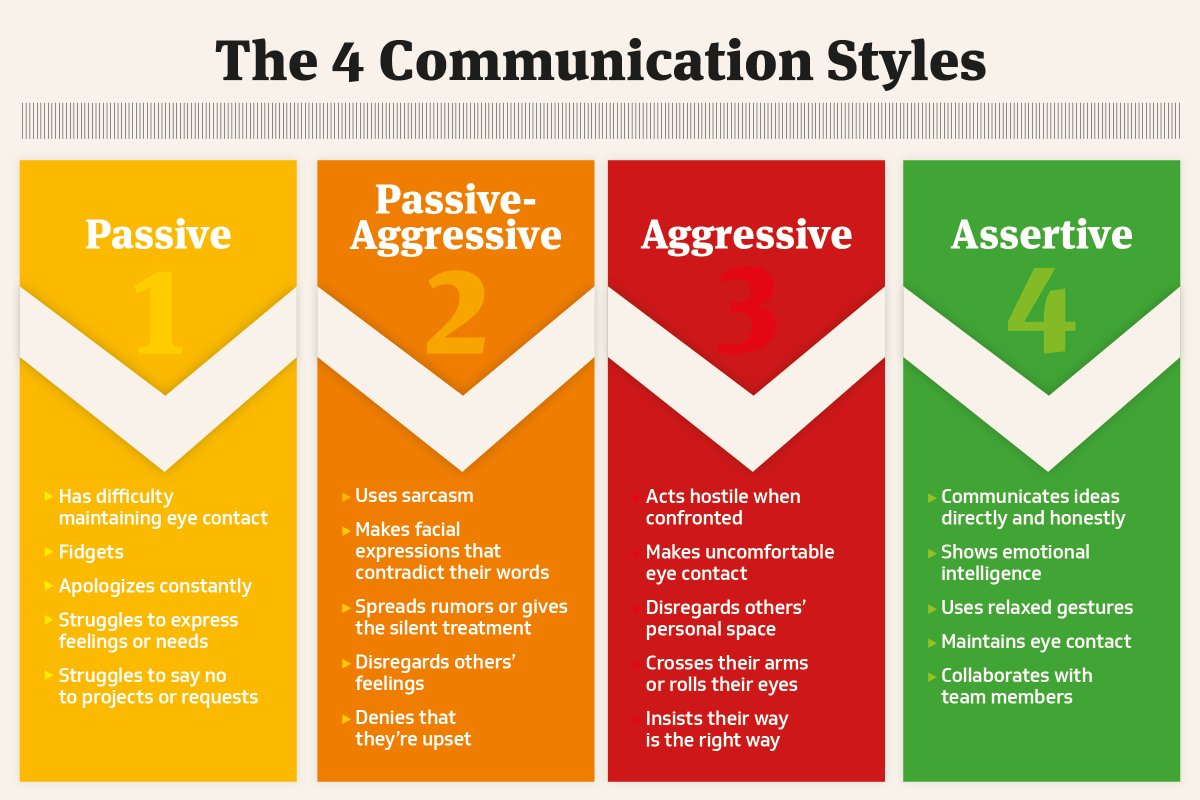Everyone communicates differently—even in the workplace. According to Princeton University, there are four main communication styles: passive, passive-aggressive, aggressive and assertive.
An assertive style generally leads to the most effective communication. But not everyone reacts the same in every interaction, so it's best to learn how to work with team members of all different communication styles.
Understanding and communicating effectively with your team can help you better work with your direct reports or teammates to achieve your goals.
Below, we'll cover why communication is key in the workplace, how to identify others' workplace communication styles and how to sharpen your own skills.

Why Is Workplace Communication Important?
BetterUp, a workplace coaching platform, states that workplace communication is crucial because it "boosts employee morale, engagement, productivity and satisfaction."
In a world where many employees decide to quiet quit their jobs, it's all the more important to motivate your team and ensure they feel respected and satisfied with their work.
Motivating your direct reports or teammates will allow you to get more done with fewer miscommunications, which can drive better results and more success overall.
The 4 Types of Communication Styles
Your communication style describes how you interact with others verbally and through body language. Let's dive into the different styles and discuss how to best interact with each one.

1. Passive Communication Style
Passive communicators are typically on the quiet side and avoid conflict or debate. Because they rarely express their feelings or needs, it may be difficult to determine if they need assistance or extra resources at work.
Passive communicators often exhibit the following behavior:
- Difficulty maintaining eye contact
- Fidgeting
- Constantly apologizing
- Struggling to express feelings or needs
- Struggling to say no to projects or request
How to Work With a Passive Communicator
Passive workplace communicators may not engage in group discussions, so one-on-one conversations are often more productive.
Global Employee Engagement Platform Vantage Circle recommends asking passive communicators for their thoughts and ideas with "broader language." This provides room for replies with less pressure. Just be sure to leave plenty of time for responses and accept periods of silence.
But passive communicators often defer to others for decision-making, according to Princeton. While you can't force someone to share their thoughts and feelings with you, you can maintain a positive, welcoming attitude to create a safe space for them to open up over time.
If you directly manage someone who exhibits passive communication, understand that they may not immediately open up to you. It'll likely be a work in progress, so remain patient.
What to Do If You Have a Passive Communication Style
If you communicate passively, Indeed suggests finding the communication format you feel comfortable with and practicing speaking up. For example, plan one-on-one meetings or communicate via writing when possible.
Try not to use this as a crutch, though. Ideally, after some time and practice, you should feel more comfortable contributing in group settings.
Mary Sharp Emerson, digital content producer at the Harvard Division of Continuing Education, also recommends that you "know what you are going to say and how you are going to say" before any type of communication. This is a great way for passive communicators to build confidence before contributing to group discussions.
2. Passive-Aggressive Communication Style
Passive-aggressive people appear to communicate passively but will subtly act out in anger. For example, they may tell you they're happy with a decision you made, then give you the silent treatment.
Here's how to identify a passive-aggressive communicator:
- Using sarcasm
- Making facial expressions that contradict their words
- Spreading rumors or giving the silent treatment
- Disregarding others' feelings
- Denying that they're upset
How to Work With a Passive-Aggressive Communicator
The Crisis & Trauma Resource Institute offers several tips for engaging with a passive-aggressive person, including:
- Using humor
- Addressing the issue as soon as possible
- Using clear, assertive communication
- Respectfully disengaging if you fail to find a successful strategy
If extreme ongoing passive-aggressive behavior negatively impacts your team's results or work environment, it may be time to consult human resources to come up with a plan for next steps.
What To Do If You Have a Passive-Aggressive Communication Style
If someone gives you feedback that you communicate passive-aggressively, be honest with yourself. Are you being fair to the person you're communicating with?
Talkspace contributor Ladan Nikraven Hayes says the first step to stopping passive-aggressiveness is recognizing the behavior. "Give yourself time" to recognize and understand your behavior, then "create a safe space to communicate in more assertive ways."
Mind Tools, a career development platform, says that some passive-aggressive people prefer using email or work chat apps instead of speaking face-to-face. Try practicing your communication skills in writing so you can get comfortable more clearly communicating with others in person too.
3. Aggressive Communication Style
Aggressive communicators will often speak over and disrespect others. Unlike someone who's passive-aggressive, an aggressive communicator is openly condescending and sarcastic.
Princeton describes this type of person as "expressing feelings, needs and ideas at the expense of others."
Aggressive communicators often exhibit the following behavior:
- Acting hostile when confronted
- Making uncomfortable eye contact
- Disregarding others' personal space
- Crossing their arms or rolling their eyes
- Insisting their way is the right way
How to Work With an Aggressive Communicator
Online job community Ivy Exec suggests dealing with an aggressive colleague by keeping your cool, showing them you're listening and being assertive. The key is to stay calm and keep emotions out of the situation.
However, it's also important to know when to walk away. If you aren't able to make positive progress, it's best to leave the situation. If this person is consistently contributing to a hostile work environment, it's wise to contact a superior or human resources to come up with a solution.
What to Do If You Have an Aggressive Communication Style
Communications coach and writer Joel Schwartzberg told Newsweek that aggressive communicators should follow the "three before me" rule. This means letting "at least three contributors speak before you speak to ensure all voices—especially the less assertive ones—are heard."
You can also use this rule to "audit what you say before you say it. Your mouth doesn't know the difference between a good point and a pointless observation; only your mind does."
Additionally, Schwartzberg recommends listening with intention: "Don't spend your listening time conceiving your next point. Listen carefully and intentionally before you respond."
And if your aggressive communication style causes you to become angry in the workplace, the Mayo Clinic suggests speaking with a mental health professional or learning anger management techniques.
4. Assertive Communication Style
Assertive communication is seen as the most effective form of communication form. The Mayo Clinic says assertive communication helps you "express yourself effectively and stand up for your point of view" while respecting others.
This is seen as the ideal in a work environment. Communicating assertively can lead to easier decision-making and reduced stress.
Assertive communicators often exhibit the following behaviors:
- Communicating ideas directly and honestly
- Showing emotional intelligence
- Using relaxed gestures
- Maintaining eye contact
- Collaborating with team members
How to Work With an Assertive Communicator
Vantage Circle recommends encouraging assertive direct reports to continue expressing their thoughts in a positive way.
You can further engage them by asking them to help work with employees who have passive, passive-aggressive, or aggressive communication styles.
How to Become More Assertive
If you want to be more assertive, Schwartzberg advises using "I" statements like "I recommend," "I propose" and "I suggest." This forces you to "make points that demand consideration and inspire response."
Another tactic is to "raise your volume." Schwartzberg conducts a workshop where he asks people to speak louder than they normally would. The participants who listed thought the speakers sounded "more confident" and even "more knowledgeable."
However, he suggests that you "share points, not just ideas." Speaking loudly doesn't automatically mean your point will be good. Sharing a specific point, backed by your credibility, is often more effective than sharing broad ideas or observations.
Here are some additional ways to practice being assertive according to the Mayo Clinic:
- Practice saying no
- Practice active listening
- Rehearse what you plan to say in advance
- Maintain eye contact and other positive body language
- Don't let emotions influence your communication
What Is Your Communication Style?
Being an assertive communicator is a great way to reduce stress and conflict in the workplace. However, learning to be an effective communicator can take time.
A good first step is to learn about your own communication style and how you can improve it. The DiSC® assessment is a tool used to help you better understand your personality and behaviors in order to communicate and work more effectively as part of a team.
For a free option, you can try 16Personalities, a personality test based on the Myers-Briggs Type Indicator® (MBTI®) test.
Understanding your personality and behaviors is a good step toward successfully communicating with all types of people in the workplace.
Uncommon Knowledge
Newsweek is committed to challenging conventional wisdom and finding connections in the search for common ground.
Newsweek is committed to challenging conventional wisdom and finding connections in the search for common ground.
About the writer
Kelly Lyons is a Newsweek editor based in the Chicagoland area. Her focus is lifestyle content. Kelly joined Newsweek in ... Read more
To read how Newsweek uses AI as a newsroom tool, Click here.






